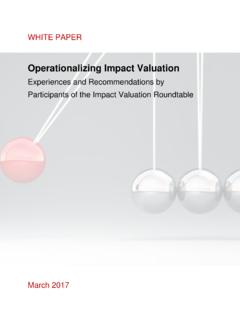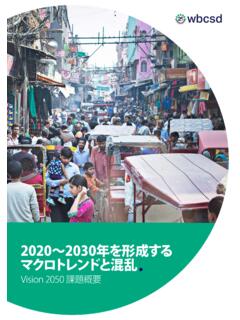Transcription of Information and communication technology
1 Business solutions for a sustainable worldInformation and communication technologyAn enabler for inclusive business solutionsTable of contentsThe growth story of ICT 2 The nexus between ICT and development 2 Examples of ICT-enabled solutions 3 Benefits and lessons learned 10 WBCSD technology Enablers Initiative 11 Notes and references 122 The growth story of ICTNot long ago access to Information and communication technology (ICT) was the privilege of a small minority of the world s population. ICT has undoubtedly transformed the way we live in the developed world: computers are now found on every office desk, and high-speed internet and mobile phones have changed the way in which we communicate, work, shop, and the turn of the century, ICT has transformed the developing world, too. Whilst in 2000 more than half of mobile phone users were in the developed world, the balance started shifting around 2005, and in 2011 about three in four users were based in the developing world (see Figure 1).
2 Today, the largest mobile phone company (by number of subscribers) is China Mobile, with over 600 million customers. However, not all technologies and services have developed at the same pace. Fixed-line telephony and broadband internet subscriptions, for example, have evolved more slowly than mobile phone use in developing countries (see Figure 2). Some concerns have also been raised that the poorest countries may be left behind and that a digital divide may be growing. Yet the latest figures from Africa, the world s poorest continent, are encouraging, in particular with regard to mobile phone connections, which reached over 620 million as of September is an important sign, as investment and innovation to boost mobile penetration have an impact on economic growth. For instance, Indian states with 10% higher mobile phone penetration see annual growth rates of higher than states with a lower mobile phone density2.
3 Many factors are driving the rapid diffusion of ICT in emerging countries: the appetite of consumers, constant innovation in the industry, increasing availability of networks, and decreasing costs of hardware and software. In fact, prices for ICT services worldwide are falling while services are growing, though at different rates: fixed broadband services showed the largest price decline (42% between 2008 and 2009), followed by mobile cellular services (25%)4. That being said, people in developing countries still have to spend relatively more of their income ( ) on ICT services than people in developed countries ( )5. The nexus between ICT and development ICT can expand the breadth and depth of economic activity in developing economies and improve the delivery of a range of essential public services. Governments of developing countries are therefore making significant investments in the infrastructure supporting ICT services.
4 For instance, three submarine data cables have been installed off the coast of Africa in 2011, a huge investment that has quadrupled mobile data speeds and cut prices by 90% in connected countries6. For its part, Kenya aims to accelerate socio-economic development by becoming a global ICT some cases, ICT can help developing countries leapfrog traditional development stages. For example, the spread of mobile phones has allowed developing countries to rapidly build a modern communication infrastructure without the need to install vast grids of fixed phone in ICT alone is not enough, though. While there is a strong link between access to ICT and development, it is not a panacea, but rather a powerful tool to tackle development Figure 1 Mobile-cellular subscriptions, by level of development200020052011 Total 719 millionTotal billionTotal 6 billionDevelopedDevelopingDevelopedDevel opingDevelopedDevelopingSource: International Telecommunications Union (2011).
5 ICT Data and Statistics. Available: Last accessed 1 December Both access to ICT and the way in which technology is used have an impact on development. Solutions must be adapted to the local context and support services available. For instance, providing computers to schools in remote areas does not necessarily foster education. Success depends on a broader set of factors including reliable and affordable electricity power, maintenance support, and of ICT-enabled solutionsMarket experience shows that access to technology drives private sector activity and innovation by local entrepreneurs and SMEs. In turn, this opens up new market opportunities and helps to better fulfill the daily needs of customers. Moreover, technology increases the potential for larger companies to connect with the poor by increasing the scale and profitability of their investment.
6 This creates opportunities not just for large technology service providers, but also for companies in other sectors that serve the poor as consumers, engage low-income entrepreneurs in their supply chains, or work with governments or other institutions to deliver key public goods and services. For companies seeking to implement ICT-enabled ventures, the key challenge they face is oftentimes not in the technology in itself, but in finding the appropriate commercial model, and ensuring that all participants derive some value. This includes weighing the costs and benefits of different types of technologies, for example the use of smart phones versus more basic the following pages, we present a number of case studies that highlight the power of ICT-enabled solutions. Many of these exemplify inclusive business models, business ventures that engage the poor on the demand side as What is ICT?
7 Information and communication technology (ICT) is an umbrella term and consists of all technical means used to handle Information and aid communication , including computer and network hardware, communication middleware as well as necessary software. In other words, it encompasses radio, television, fixed and cellular phones, computers and networks, satellite systems and so on, as well as the various services and applications associated with them. This definition informs our discussion in this *Global ICT developments, 2001-2011*Mobile-cellular telephone subscriptionsInternet usersFixed telephone linesActive mobile-broadband subscriptionsFixed (wired)-broadband subscriptions* estimate. Per 100 inhabitantsFigure 2 Global ICT development, 2001-2011 3 Source: International Telecommunications Union (2011). ICT Data and Statistics. Available: Last accessed 1 December and customers and on the supply side as employees, producers, and business owners.
8 Table 1 provides some examples of solutions across sectors and along the value chain. They are a mixture of commercial and more philanthropic activities using technology . The list should not be seen as exhaustive. As the sector develops further and new technologies and standards emerge, new opportunities to leverage technology will become Table 1: Some examples of ICT-enabled solutions across sectors and along the value chainAgricultureFoodHealthEmergency responseWater and energyBanking and insuranceEducationGovernment services & crowdvoicingRemote data collectionSeed distribution, crop levels Food availability Patient data, medical supply inventory Impact resulting from emergency Water quality, tree planting Market analysis Criminal intelligence data, population surveys and ID Education & awareness raising Access to market prices, weather Customer Information Medical reminders Arrival of emergency supplies Population alertsCustomer informationAvailability and usage of online educational materials Awareness of local events/issues communication and training (two-way dialogue)
9 Field agents capacity Coordination of distribution networkHealth worker capacity Alert and coordination systems, online bulletin boards Customer serviceCustomized ATM machines Teacher training, online educational communitiesElection participation/ results Analysis and reportingCrop levels Hunger and malnutrition analysis Patient compliance analysisThreat- and risk- mapping analysis Sustainability analysis Mobile portfolio management Security monitoring, trends analysisTracking (geographic Information ) GPS data, plant diseases Supply chain management, tracking food vouchersHuman diseases, medicine delivery Disaster assessments, supply chain managementGeospatial mapping of water sourcesGeo-marketing Peace incidents, security monitoring Remote services, incl. last mile and security of informationAutomatic detection of plant diseases, irrigation need Patient diagnostic Family reunification, job opportunities, fundraising MeteringMobile banking and payments e-government, m-government 5 AgricultureFoodHealthEmergency responseWater and energyBanking and insuranceEducationGovernment services & crowdvoicingRemote data collectionSeed distribution, crop levels Food availability Patient data, medical supply inventory Impact resulting from emergency Water quality, tree planting Market analysis Criminal intelligence data, population surveys and ID Education & awareness raising Access to market prices.
10 Weather Customer Information Medical reminders Arrival of emergency supplies Population alertsCustomer informationAvailability and usage of online educational materials Awareness of local events/issues communication and training (two-way dialogue)Field agents capacity Coordination of distribution networkHealth worker capacity Alert and coordination systems, online bulletin boards Customer serviceCustomized ATM machines Teacher training, online educational communitiesElection participation/ results Analysis and reportingCrop levels Hunger and malnutrition analysis Patient compliance analysisThreat- and risk- mapping analysis Sustainability analysis Mobile portfolio management Security monitoring, trends analysisTracking (geographic Information ) GPS data, plant diseases Supply chain management, tracking food vouchersHuman diseases, medicine delivery Disaster assessments, supply chain managementGeospatial mapping of water sourcesGeo-marketing Peace incidents, security monitoring Remote services, incl.








